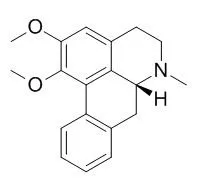| Kinase Assay: |
| J Ethnopharmacol. 2012 Jul 13;142(2):488-95. | | Nuciferine stimulates insulin secretion from beta cells-an in vitro comparison with glibenclamide.[Pubmed: 22633982 ] | Several Asian plants are known for their anti-diabetic properties and produce alkaloids and flavonoids that may stimulate insulin secretion.
METHODS AND RESULTS:
Using Vietnamese plants (Nelumbo nucifera, Gynostemma pentaphyllum, Smilax glabra, and Stemona tuberosa), we extracted two alkaloids (neotuberostemonine, Nuciferine) and four flavonoids (astilbin, engeletin, smitilbin, and 3,5,3'-trihydroxy-7,4'-dimethoxyflavone), and studied their insulin stimulatory effects.
Nuciferine, extracted from Nelumbo nucifera, stimulated both phases of insulin secretion in isolated islets, whereas the other compounds had no effect. The effect of Nuciferine was totally abolished by diazoxide and nimodipine, and diminished by protein kinase A and protein kinase C inhibition. Nuciferine and potassium had additive effects on insulin secretion. Nuciferine also stimulated insulin secretion in INS-1E cells at both 3.3 and 16.7 mM glucose concentrations. Compared with glibenclamide, Nuciferine had a stronger effect on insulin secretion and less beta-cell toxicity. However, Nuciferine did not compete with glibenclamide for binding to the sulfonylurea receptor.
CONCLUSIONS:
Among several compounds extracted from anti-diabetic plants, Nuciferine was found to stimulate insulin secretion by closing potassium-adenosine triphosphate channels, explaining anti-diabetic effects of Nelumbo nucifera. |
|
| Cell Research: |
| J Ethnopharmacol. 2015 May 13;165:83-93. | | Nuciferine, extracted from Nelumbo nucifera Gaertn, inhibits tumor-promoting effect of nicotine involving Wnt/β-catenin signaling in non-small cell lung cancer.[Pubmed: 25698245 ] | The leaves of Nelumbo nucifera Gaertn are recorded in the earliest written documentation of traditional Chinese medicinal as "Ben Cao Gang Mu", a medicinal herb for blood clotting, dysentery and dizziness. Recently, Nuciferine (NF), one of N. nucifera Gaertn leaf extracts has been shown to possess several pharmacological properties, including anti-viral and anti-cancer. The aim of this study is to investigate the underlying molecular mechanism of the anti-cancer activity of NF in NSCLC progression induced by nicotine.
METHODS AND RESULTS:
NF significantly inhibited the proliferation of NSCLC cells in the presence of nicotine, suppressed the activity of Wnt/β-catenin signaling, enhanced the stabilization of Axin, and induced apoptosis. NF down-regulated the expression levels of β-catenin and its downstream targets including c-myc, cyclin D and VEGF-A. NF also decreased the ratio of Bcl-2/Bax, which may explain the pro-apoptosis effect of NF. In tumor xenograft nude mice, NF not only inhibited the growth of non-small cell lung cancer (NSCLC) cells, but also remarkably alleviated the injury induced by nicotine in liver function.
CONCLUSIONS:
NF has the remarkable effect to inhibit nicotine-induced NSCLC progression, which was due to its ability to reduce the activity of Wnt/β-catenin signaling.
Thus, the work stated here emphasizes the importance of this traditional medicine and presents a potential novel alternative to NSCLC prevention and therapy. |
|
| Animal Research: |
| Eur J Pharmacol. 2015 Jan 15;747:59-70. | | Nuciferine restores potassium oxonate-induced hyperuricemia and kidney inflammation in mice.[Pubmed: 25499818] |
METHODS AND RESULTS:
Nuciferine, a major aporphine alkaloid of the leaves of Nelumbo nucifera, was found to decrease serum urate levels and improved kidney function, as well as inhibited system and renal interleukin-1β (IL-1β) secretion in potassium oxonate-induced hyperuricemic mice. Furthermore, Nuciferine reversed expression alteration of renal urate transporter 1 (URAT1), glucose transporter 9 (GLUT9), ATP-binding cassette, subfamily G, membrane 2 (ABCG2), organic anion transporter 1 (OAT1), organic cation transporter 1 (OCT1), and organic cation/carnitine transporters 1/2 (OCTN1/2) in hyperuricemic mice. More importantly, Nuciferine suppressed renal activation of Toll-like receptor 4/myeloid differentiation factor 88/NF-kappaB (TLR4/MyD88/NF-κB) signaling and NOD-like receptor family, pyrin domain containing 3 (NLRP3) inflammasome to reduce serum and renal IL-1β levels in hyperuricemic mice with renal inflammation reduction. The anti-inflammatroy effect of Nuciferine was also confirmed in human proximal renal tubular epithelial cells (HK-2 cells) incubated with 4mg/dl uric acid for 24h.
CONCLUSIONS:
This study firstly reported the anti-hyperuricemic and anti-inflammatory effects of Nuciferine by regulating renal organic ion transporters and inflammatory signaling in hyperuricemia. These results suggest that a dietary supplement of Nuciferine rich in lotus leaf may be potential for the prevention and treatment of hyperuricemia with kidney inflammation. |
|
| Structure Identification: |
| J Chromatogr B Analyt Technol Biomed Life Sci. 2014 Jun 15;961:20-8. | | A sensitive liquid chromatography-tandem mass spectrometry method for pharmacokinetics and tissue distribution of nuciferine in rats.[Pubmed: 24854711] | Nuciferine is an important drug candidate for the treatment of obesity-related diseases. However, few investigations have been conducted about the pharmacokinetics and tissue distribution of Nuciferine to better understand its behavior and action mechanism in vivo.
METHODS AND RESULTS:
Thus, a sensitive and reliable liquid chromatography with tandem mass spectrometry (HPLC-MS/MS) method was established and validated for the quantification of Nuciferine in rat plasma and tissue samples. The validated method was successfully applied to the pharmacokinetic and tissue distribution study of Nuciferine in rats. One-compartmental pharmacokinetic parameters indicated that Nuciferine had rapid distribution, extensive tissue uptake, and poor absorption into systemic circulation. The values of absolute bioavailability were (3.8±1.4)%, (4.2±1.3)% and (3.9±1.0)% after oral administration of 2.0, 5.0 and 10.0mg/kg Nuciferine and intravenous administration of 0.2mg/kg Nuciferine in rats. The results of the tissue distribution study suggested that Nuciferine was distributed into the brain, liver and adipose tissue after intravenous administration.
CONCLUSIONS:
In conclusion, the present study may provide a material basis for study of the pharmacological action of Nuciferine in the treatment of obesity, and meaningful insights into further study on dosage modification. |
|






 Cell. 2018 Jan 11;172(1-2):249-261.e12. doi: 10.1016/j.cell.2017.12.019.IF=36.216(2019)
Cell. 2018 Jan 11;172(1-2):249-261.e12. doi: 10.1016/j.cell.2017.12.019.IF=36.216(2019) Cell Metab. 2020 Mar 3;31(3):534-548.e5. doi: 10.1016/j.cmet.2020.01.002.IF=22.415(2019)
Cell Metab. 2020 Mar 3;31(3):534-548.e5. doi: 10.1016/j.cmet.2020.01.002.IF=22.415(2019) Mol Cell. 2017 Nov 16;68(4):673-685.e6. doi: 10.1016/j.molcel.2017.10.022.IF=14.548(2019)
Mol Cell. 2017 Nov 16;68(4):673-685.e6. doi: 10.1016/j.molcel.2017.10.022.IF=14.548(2019)